OpenAI’s July 17 launch of ChatGPT Agents is being hailed as a breakthrough—but it may also be a turning point in how we understand AI’s role in our businesses, our privacy, and our digital autonomy.
“OpenAI just launched something on July 17 that will change your business forever: ChatGPT Agent,” shares Iterate.ai CEO Jon Nordmark. “This isn’t just another chatbot. It’s an AI that takes real actions. It can book flights with your credit card. It can read your confidential files and make decisions without asking permission.”
These agents represent a fundamental shift in the architecture of AI. Built to operate independently, ChatGPT Agents and their counterparts are being programmed to act on behalf of users, across calendars, messaging systems, email, documents, finances, and more. Their strength lies in their ability to access and synthesize data across multiple systems, and in their ability to remember.
Nordmark points out that these agents are capable of maintaining persistent memory—often without user visibility or control. That memory, he notes, can include deeply personal and identifying information. “This memory isn’t neutral. It’s predictive, pattern-based, and often invisible,” Nordmark explains. “You can’t see what it remembers. Or how it’s using that memory to act on your behalf.”
This memory forms what is called a “Digital You”—an inferred, AI-generated version of the user that can act without ongoing input. “This may sound extreme,” Nordmark says, “but if your calendar shows a 3PM break, your location pings near a Starbucks, and your expense log shows a $4.25 charge, the agent puts it together. When agents get access to calendars, messages, receipts, apps, and location history, they don’t see you sipping—they infer it with startling precision.”
That kind of inference brings up critical concerns, especially around security, transparency, and control. Agents with memory and real-time access to sensitive data pose a unique risk: they are not just interpreting your behavior—they’re executing on your behalf. Nordmark notes that these agents operate on shared infrastructure with other companies and individuals, which creates systemic vulnerabilities.
“In fact, agents built by all big public LLM builders—OpenAI (ChatGPT), Google (Gemini), Anthropic (Claude), DeepSeek (China), Manus (China)—all run on a massive cloud platform,” Nordmark explains. “Each request (i.e. prompt) is processed across hundreds (or thousands) of GPUs or TPUs to support tools, memory, and real-time actions.”
That infrastructure, while powerful, is also communal. Data belonging to companies and individual users is being processed simultaneously in environments that were not originally designed for this level of persistent, autonomous access. The implications for cybersecurity are far-reaching. Nordmark warns: “When agents live on shared infrastructure, one weak link becomes everyone’s risk.”
That shared vulnerability is especially concerning when agents are granted permissions to access bank accounts, customer databases, internal communications, and payment platforms. If a hacker were to hijack an agent or intercept the data it processes, the result could be catastrophic.
The issue is not just technical, it’s strategic. Businesses are deploying these tools quickly to gain an edge or boost productivity, but without fully understanding how the systems operate or how to protect themselves. In doing so, they may be embedding insecure practices into the very foundation of their AI strategy.
“As leaders, we need to think twice before encouraging employees to use memory-hoarding agents—ones that act without human judgment—inside shared-cloud environments,” concludes Nordmark.
Companies eager to adopt AI agents must first grapple with the ethical and logistical implications. Questions about data deletion, long-term storage, agent behavior, and breach recovery need clear answers. Without them, the promise of these tools could quickly become a liability.
The power of AI agents is undeniable, but so are the risks. As the technology continues to advance, business leaders will need to balance innovation with caution, making decisions that prioritize both growth and the safety of their people and data.



